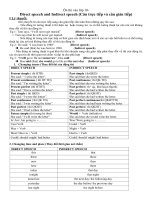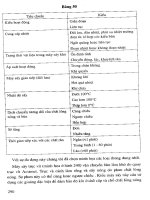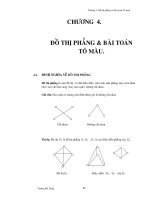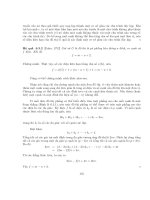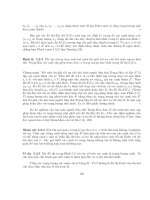Lí thuyết đồ thị part 10 pps
Bạn đang xem bản rút gọn của tài liệu. Xem và tải ngay bản đầy đủ của tài liệu tại đây (97.72 KB, 14 trang )
typedef byte SetOfVertices[(MAXVERTICES%8)?((MAXVERTICES/8)+1):(MAXVERTICES/8)];
/***********************************
Danh sach da lien ket cho cac canh
***********************************/
typedef struct EdgeNode *EdgePointer;
struct EdgeNode
{
byte Vertex[2];
EdgePointer Link[2];
};
typedef struct
{
char Data;
EdgePointer Next;
} ListEdge;
typedef ListEdge *ListEdgePointer;
typedef ListEdgePointer ArrayOfEdge[MAXVERTICES];
/***** Phan khai bao prototype ham *****/
void Create(AdjPointer *List);
Boolean Empty(AdjPointer List);
void Push(AdjPointer *List, byte Item);
void Pop(AdjPointer *List, byte *Item);
void CreatQueue(Queue *Q);
Boolean EmptyQueue(Queue Q);
void PushQueue(Queue *Q, byte Item);
void PopQueue(Queue *Q, byte *Item);
Boolean EmptySet(SetOfVertices S);
Boolean InSet(SetOfVertices S, byte Value);
void InitSet(SetOfVertices S, byte MaxValue);
void AddSet(SetOfVertices S, byte Value);
void SubSet(SetOfVertices S, byte Value);
void MakeV_out(char *FileName, ArrayOfPointer V_out, byte *NumVertices,
199
Boolean Weight);
void MakeV_in(char *FileName, ArrayOfPointer V_in, ArrayOfPointer V_out,
byte *NumVertices);
void BuildGraph(char *FileName, ArrayOfEdge E, byte *NumVertices);
void DisplayV_out(ArrayOfPointer V_out, byte NumVertices, Boolean Weight);
void DisplayV_in(ArrayOfPointer V_in, byte NumVertices);
void DFS(ArrayOfEdge E, byte Start, SetOfVertices S);
void PathTwoVertex(Path Pred, byte Start, byte Terminal);
void PopHeadPtr(byte NumVertices, ArrayOfPointer V_out);
/***** Phan cai dat cac ham *****/
void Create(AdjPointer *List)
{
(*List) = NULL;
}
Boolean Empty(AdjPointer List)
{
return((List == NULL) ? TRUE : FALSE);
}
void Push(AdjPointer *List, byte Item)
{
AdjPointer TempPtr;
TempPtr = (AdjPointer) malloc(sizeof(struct VertexNode));
TempPtr->Vertex = Item;
TempPtr->Next = (*List);
(*List) = TempPtr;
}
void Pop(AdjPointer *List, byte *Item)
{
AdjPointer TempPtr;
if (Empty(*List))
{
printf(" Thao tac con tro khong hop le ");
return;
200
}
TempPtr = (*List);
(*Item) = TempPtr->Vertex;
(*List) = TempPtr->Next;
free(TempPtr);
}
void CreatQueue(Queue *Q)
{
(*Q).Head = NULL;
}
Boolean EmptyQueue(Queue Q)
{
return((Q.Head == NULL) ? TRUE : FALSE);
}
void PushQueue(Queue *Q, byte Item)
{
QueueNode TempPtr;
TempPtr = (QueueNode) malloc(sizeof(struct QueueType));
TempPtr->Vertex = Item;
TempPtr->Next = NULL;
if ((*Q).Head == NULL) (*Q).Head = TempPtr;
else (*Q).Tail->Next = TempPtr;
(*Q).Tail = TempPtr;
}
void PopQueue(Queue *Q, byte *Item)
{
QueueNode TempPtr;
if (EmptyQueue(*Q))
{
printf(" Thao tac con tro khong hop le ");
return;
}
TempPtr = (*Q).Head;
(*Item) = TempPtr->Vertex;
(*Q).Head = TempPtr->Next;
free(TempPtr);
201
}
Boolean EmptySet(SetOfVertices S)
{
int i, k = (MAXVERTICES %8 ) ? ((MAXVERTICES / 8) + 1) : (MAXVERTICES / 8);
for (i = 0; i < k; i++)
if (S[i] != 0) return(FALSE);
return(TRUE);
}
Boolean InSet(SetOfVertices S, byte Value)
{
if ((Value < 1) || (Value > MAXVERTICES))
return(FALSE);
return((S[(Value - 1) / 8] & (0x80 >> ((Value - 1) % 8))) ? TRUE : FALSE);
}
void InitSet(SetOfVertices S, byte MaxValue)
{
int i;
if (MaxValue>MAXVERTICES)
{
printf(" Gia tri khong thuoc tap hop ");
return;
}
for (i = 0; i < MaxValue; i++) S[i/8] |= 0x80 >> (i%8);
}
void AddSet(SetOfVertices S, byte Value)
{
int i;
if ((Value < 1) || (Value > MAXVERTICES))
{
printf(" Gia tri khong thuoc tap hop ");
return;
}
202
S[(Value-1)/8] |= 0x80 >> ((Value-1)%8);
}
void SubSet(SetOfVertices S, byte Value)
{
if ((Value < 1) || (Value > MAXVERTICES))
{
printf(" Gia tri khong thuoc tap hop ");
return;
}
S[(Value-1)/8] &= ~(0x80 >> ((Value-1)%8));
}
int feoln(FILE *fp)
{
char c;
if ((c=fgetc(fp))==10)
{
fseek(fp, -2, 1);
return(TRUE);
}
else
if (c==EOF) return(TRUE);
else
{
fseek(fp, -1, 1);
return(FALSE);
}
}
void freadln(FILE *fp)
{
char c;
while (((c=fgetc(fp))!=10)&&(c!=EOF));
}
void MakeV_out(char *FileName, ArrayOfPointer V_out, byte *NumVertices,
Boolean Weight)
{
203
byte NumVert;
HeadPointer HeadPtr;
AdjPointer VerPtr;
FILE *FileData;
if ((FileData = fopen(FileName, "rt")) == NULL)
{
printf(" File khong tim thay ");
return;
}
NumVert = 0;
while (!feof(FileData))
{
HeadPtr = (HeadPointer) malloc(sizeof(HeadNode));
HeadPtr->Next = NULL;
fgets(HeadPtr->Data, MAXSTRINGS+1, FileData);
// Ham fgets(char *s, int n, FILE *fp) chi doc n-1 ky tu
while (!feoln(FileData))
{
VerPtr = (AdjPointer) malloc(sizeof(struct VertexNode));
fscanf(FileData, "%d", &(VerPtr->Vertex));
if (Weight)
{
fscanf(FileData, "%d", &(VerPtr->Length));
VerPtr->Flow = 0;
}
VerPtr->Next = HeadPtr->Next;
HeadPtr->Next = VerPtr;
}
freadln(FileData);
++NumVert;
V_out[NumVert] = HeadPtr;
}
(*NumVertices) = NumVert;
fclose(FileData);
}
void MakeV_in(char *FileName, ArrayOfPointer V_in, ArrayOfPointer V_out,
byte *NumVertices);
{
byte NumVert;
204
int i, j;
HeadPointer HeadPtr;
AdjPointer CurrPtr, VerPtr;
MakeV_out(FileName, V_out, &NumVert, TRUE);
(*NumVertices) = NumVert;
for (i=1; i<=NumVert; i++)
{
HeadPtr = (HeadPointer) malloc(sizeof(HeadNode));
strcpy(HeadPtr->Data, V_out[i]->Data);
HeadPtr->Next = NULL;
for (j=1; j<=NumVert; j++)
{
CurrPtr = V_out[j]->Next;
while (CurrPtr!=NULL)
{
if (CurrPtr->Vertex==i)
{
VerPtr=(AdjPointer)malloc(sizeof(struct VertexNode));
VerPtr->Vertex = j;
VerPtr->Length = CurrPtr->Length;
VerPtr->Flow = 0;
VerPtr->Next = HeadPtr->Next;
HeadPtr->Next = VerPtr;
}
CurrPtr = CurrPtr->Next;
}
}
V_in[i] = HeadPtr;
}
}
void BuildGraph(char *FileName, ArrayOfEdge E, byte *NumVertices)
{
byte EndPt, NumVert;
int i;
char ch[2];
EdgePointer EdgePtr;
FILE *FileData;
if ((FileData = fopen(FileName, "rt")) == NULL)
{
205
printf(" File khong tim thay ");
return;
}
NumVert = 0;
while (!feoln(FileData))
{
++NumVert;
E[NumVert] = (ListEdgePointer) malloc(sizeof(ListEdge));
fscanf(FileData, "%s", ch);
E[NumVert]->Data = ch[0];
E[NumVert]->Next = NULL;
}
(*NumVertices) = NumVert;
for (i=1; i<=NumVert; i++) printf("%c ", E[i]->Data);
printf("\n");
freadln(FileData);
while (!feof(FileData))
{
EdgePtr = (EdgePointer) malloc(sizeof(struct EdgeNode));
for (i=0; i<2; i++)
{
fscanf(FileData, "%d", &EndPt);
printf("%d ", EndPt);
EdgePtr->Vertex[i] = EndPt;
EdgePtr->Link[i] = E[EndPt]->Next;
E[EndPt]->Next = EdgePtr;
}
printf("\n");
freadln(FileData);
}
fclose(FileData);
}
void DFS(ArrayOfEdge E, byte Start, SetOfVertices Unvisited)
{
EdgePointer Ptr;
byte StartEnd, OtherEnd, NewStart;
SubSet(Unvisited, Start);
206
Ptr = E[Start]->Next;
while ((!EmptySet(Unvisited))&&(Ptr!=NULL))
{
StartEnd = 0;
OtherEnd = 1;
if (Ptr->Vertex[0]!=Start)
{
StartEnd = 1;
OtherEnd = 0;
}
NewStart = Ptr->Vertex[OtherEnd];
if (InSet(Unvisited, NewStart)) DFS(E, NewStart, Unvisited);
Ptr = Ptr->Link[StartEnd];
}
}
void DisplayV_out(ArrayOfPointer V_out, byte NumVertices, Boolean Weight)
{
int i;
AdjPointer CurrPtr;
for (i=1; i<=NumVertices; i++)
{
printf("(%d) %s ", i, V_out[i]->Data);
CurrPtr = V_out[i]->Next;
while (CurrPtr!=NULL)
{
printf("%d ", CurrPtr->Vertex);
if (Weight) printf("%d ", CurrPtr->Length);
CurrPtr = CurrPtr->Next;
}
printf("\n");
}
printf("\n");
}
void DisplayV_in(ArrayOfPointer V_in, byte NumVertices)
{
int i;
AdjPointer CurrPtr;
for (i=1; i<=NumVertices; i++)
207
{
printf("%s ", V_in[i]->Data);
CurrPtr = V_in[i]->Next;
while (CurrPtr!=NULL)
{
printf(" %d %d", CurrPtr->Vertex, CurrPtr->Length);
CurrPtr = CurrPtr->Next;
}
printf("\n");
}
}
void PathTwoVertex(Path Pred, byte Start, byte Terminal)
{
if (Terminal != Start)
{
PathTwoVertex(Pred, Start, Pred[Terminal]);
printf(" > %2d", Terminal);
}
}
void PopHeadPtr(byte NumVertices, ArrayOfPointer V_out)
{
byte Item;
int i;
AdjPointer CurrPtr;
for (i=1; i<=NumVertices; i++)
{
CurrPtr = V_out[i]->Next;
while (CurrPtr != NULL) Pop(&CurrPtr, &Item);
free(V_out[i]);
}
}
#endif
208
T`ai liˆe
.
u tham kha
˙’
o
[1] Appel K., The proof of the four-colour problem, New Scientist. 72, 154-155 (1976).
[2] Arlinghaus S., Arlinghaus W., Nystuen J., The Hedetniemi matrix sum: an algorithm
for shortest path and shortest distance, Geographical Analysis, Vol. 22, No. 4, Oct.,
351-360 (1990).
[3] Bellman R., On a routing problem, Quart. of Applied Mathematics, 16, 87 (1958).
[4] Berge C., L´y thuyˆe
´
t d¯ˆo
`
thi
.
v`a ´u
.
ng du
.
ng, NXB Khoa ho
.
c v`a K˜y thuˆa
.
t H`a Nˆo
.
i, 1971.
[5] Berge C., Two theorems in graph theory, Proc. Nat. Ac. Sc., 43, 842 (1957).
[6] Berry R. C., A constrained shortest path, Paper presented at the 39th National ORSA
Metting, Dallas, Texas (1971).
[7] Bondy J. A., Properties of graphs with constraints on degrees, Studia Sci. Math. Hung.
4 473-475 (1969).
[8] Bondy J. A., Chvatal V., A method in graph theory, Discrete Math. 15, 111-135 (1976).
[9] Brooks R. L., On coloring the nodes of a network, Proc. Cambridge Phil. Soc., Vol. 37,
194-197 (1941).
[10] Busacker R. G., Gowen P. J., A procedure for determining a family of minimal-cost
network flow patterns, Operations Research Office, Technical paper 15 (1961).
[11] Cayley A., Collected papers, Quart. Jl. of Mathematics, 13 Cambridge, 26 (1897).
[12] Chase S. M., Analysis of algorithms for finding all spanning trees of a graph, Report
No. 401, Department of Computer Science, University of Illinois, Urbana, Oct. (1970).
[13] Chvatal V., On Hamilton’s ideals, J. Combinat. Theory B 12 163-168 (1972).
[14] Christofides N., Graph theory an algorithmic approach, Academic Press INC. (1975).
209
[15] Coxeter H. S. M., Introduction to geometry, Wiley, New York (1961).
[16] Danzig G. B., All shortest routes in a graph, in Th´eorie des graphes, Proceedings of the
International Symposium, Rome 1966, Dunod, Paris, 91-92 (1967).
[17] Dirac G. A., Some theorems on abstract graphs, Proc. London Math. Soc. 2, 68-81
(1952).
[18] De Freisseix H., Rosenstiehl P., The depth-search theorem for planarity, in Proceedings
of the Cambridge Combinatorial Conference, North Holland, Amsterdam (1982).
[19] Deo N., Graph theory with applications to engineering and computer science, Prentice-
Hall Inc. (1974).
[20] Dijkstra, E. W., A note on two problems in connection with graphs, Numerische Math-
ematik, 1, 269 (1959).
[21] Dreyfus S. E., Wagner R. A., The Steiner problem in graphs, Networks, 1, 195 (1972).
[22] Euler L., Solutio problematis ad geometriam situs pertinentis, Commun. Acad. Sci. Imp.
Petropol. 8, Opera Omnia (1), Vol. 7, 128-140 (1736).
[23] Euler L., Commentationes Arithmeticae collectae, St. Petersburg, (1766).
[24] Fary I., On straight line representation of planar graphs, Acta Sci. Math. Szeged, Vol.
11, 229-293 (1948).
[25] Floyd R. W., Algorithm 97-Shortest path, Comm. of ACM, 5, 345 (1962).
[26] Ford L. R. Jr., Network flow theory, Rand Corporation Report 923 (1946).
[27] Ford L. R., Fulkerson D. R., Flows in networks, Princeton University Press, Princeton
(1962).
[28] Gilbert E. N., Pollack H. O., Steiner minimal trees, Jl. of SIAM (Appl. Math.), 16 1
(1968).
[29] Gomory R. E., Hu T. C., Synthesis of a communication network, Jl. of SIAM (App.
Math.), 12 348 (1964).
[30] Gondran M., Minoux M., Vajda S., Graphs and algorithms, John Wiley & Sons (1990).
[31] Hamming R. W., Coding and information theory, Prentice Hall (1980).
[32] Hanan M., On Steiner’s problem with rectilinear distance, Jl. of SIAM (Appl. Math.),
14 255 (1966).
210
[33] Hopcroft J. E., Tarjan R. E., Isomorphism of planar graphs, in Complexity of Computer
Computations, Plenum, New York (1972).
[34] Hopcroft J. E., Tarjan R. E., Efficient planarity testing, J. ACM 21, 549-568 (1974).
[35] Hu T. C., Integer programming and network flows, Addison-Wesley, Reading, Mas-
sachusetts (1969).
[36] Kerchenbaum A., Van Slyke R., Computing minimum spanning trees efficiently, Proc.
of the Ann. Conf. of ACM, Boston, 518 (1972).
[37] Kirchhoff G., in “Annalen der Physik and Chemie” 72, 497 (1847).
[38] Klein M., A primal method for minimal cost flows with applications to the assignment
and transportation problems, Man. Sci., 14, 205 (1967).
[39] Kruskal J. B. Jr., On the shortest spanning subtree of a graph and the traveling salesman
problem, Proc. American Mathematical Soc., 7, 48 (1956).
[40] Kraitchik M., Le probl`eme des Reines, Bruxelles (1926).
[41] Kevin V., Whitney M., Algorithm 422-Minimum spanning tree, Comm. of ACM, 15,
273 (1972).
[42] Las Vergnas M., Probl`emes de couplage et probl`emes hamiltoniens en th´eorie des
graphes, Doctoral thesis, Univsit´e de Paris VI (1972).
[43] Larry N., Sanford L., Lˆa
.
p tr`ınh nˆang cao bˇa
`
ng Pascal v´o
.
i c´ac cˆa
´
u tr´uc d˜u
.
liˆe
.
u, Scitec.
[44] Mei-Ko Kwan, Graphic programming using odd or even points, Chinese Math. 1, 273
(1962).
[45] Moore E. F., The shortest path through a maze, Proc. Int. Symp. on the Theory of
Switching, Path II, 285 (1957).
[46] Murchland J. D., A new method for finding all elementary paths in a complete directed
graph, London School of Economics, Report LSE-TNT-22 (1965).
[47] Ore O., Note on Hamilton circuits, Amer. Math. Mothly, 67, 55 (1960).
[48] Ore O., The four colour problem, Academic Press, New York (1967).
[49] Prim R. C., Shortest connection networks and some generalizations, Bell Syst. Tech.
Jl., 36, 1389 (1957).
[50] Paton K., An algorithm for finding a fundamental set of cycles of a graph, Comm. ACM,
Vol. 12, No. 9, Sept., 514-518 (1969).
211
[51] P´osa L., A theorem concerning Hamiltonian lines, Magyar Tud. Akad. Mat. Kutat´o
Inst. Kozl 7 255-226 (1962).
[52] Shirey R. W., Implementation and analysis of efficient graph planarity testing algo-
rithms, Ph.D. Dissertation, Computer Sciences, University of Wisconsin, Madison,
Wisc. (1969).
[53] Tarjan R., Depth-first search and linear graph algorithms, SIAM J. Computer 1 146-160
(1972).
[54] Tutte W. T., How to draw graph, Proc. London Math. Soc., Ser. 3, Vol. 13, 743-768
(1963).
[55] Whitney H., 2−Isomorphic graphs, Am. J. Math. Vol. 55 245-254 (1933).
212

